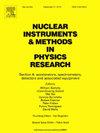miniTRASGO:用于宇宙射线研究的紧凑型RPC跟踪器
IF 1.5
3区 物理与天体物理
Q3 INSTRUMENTS & INSTRUMENTATION
Nuclear Instruments & Methods in Physics Research Section A-accelerators Spectrometers Detectors and Associated Equipment
Pub Date : 2025-04-16
DOI:10.1016/j.nima.2025.170511
引用次数: 0
摘要
miniTRASGO探测器是一种紧凑的,具有成本效益的介子跟踪器,旨在监测次级宇宙射线,用于宇宙射线物理,太阳活动和大气相关性的研究。它由电阻板室(RPCs)和HADES实验衍生的DAQ系统组成,具有稳定的检测率和高灵敏度,在马德里站(40.4°N, 7 GV)检测到Forbush减少候选体。这一结果突出了探测器的可靠性,即使它的活动面积很小,只有0.1平方米。此外,miniTRASGO还在华沙、普埃布拉和蒙特雷部署,分别位于不同的纬度(分别为52°N、19°N和25°N),并具有不同的磁截止刚度(2.5 GV、8.2 GV和8.5 GV),为建立全球μ子监测网络提供了可扩展的解决方案。本文章由计算机程序翻译,如有差异,请以英文原文为准。
miniTRASGO: A compact RPC tracker for cosmic ray studies
The miniTRASGO detector is a compact, cost-effective muon tracker designed to monitor secondary cosmic rays for studies in cosmic ray physics, solar activity, and atmospheric correlations. Built with Resistive Plate Chambers (RPCs) and a DAQ system derived from the HADES experiment, it achieves stable detection rates and high sensitivity, highlighted by the detection of a Forbush Decrease candidate at the Madrid station (40.4 °N, 7 GV). This result highlights the detector’s reliability, even with its small active area of 0.1 m2. With additional deployments in Warsaw, Puebla, and Monterrey, each located at distinct latitudes (52 °N, 19 °N, 25 °N, respectively) and characterized by varying magnetic cutoff rigidities (2.5 GV, 8.2 GV, and 8.5 GV), the miniTRASGO provides a scalable solution for establishing a global muon monitor network.
求助全文
通过发布文献求助,成功后即可免费获取论文全文。
去求助
来源期刊
CiteScore
3.20
自引率
21.40%
发文量
787
审稿时长
1 months
期刊介绍:
Section A of Nuclear Instruments and Methods in Physics Research publishes papers on design, manufacturing and performance of scientific instruments with an emphasis on large scale facilities. This includes the development of particle accelerators, ion sources, beam transport systems and target arrangements as well as the use of secondary phenomena such as synchrotron radiation and free electron lasers. It also includes all types of instrumentation for the detection and spectrometry of radiations from high energy processes and nuclear decays, as well as instrumentation for experiments at nuclear reactors. Specialized electronics for nuclear and other types of spectrometry as well as computerization of measurements and control systems in this area also find their place in the A section.
Theoretical as well as experimental papers are accepted.

 求助内容:
求助内容: 应助结果提醒方式:
应助结果提醒方式:


